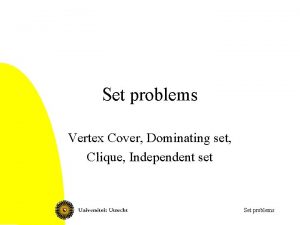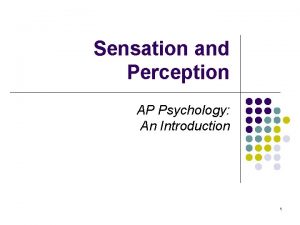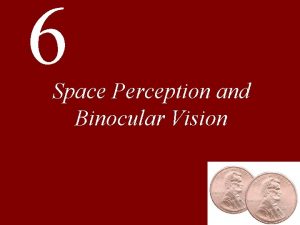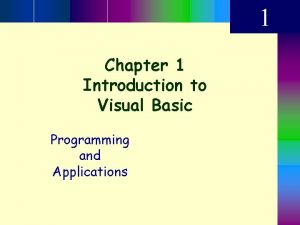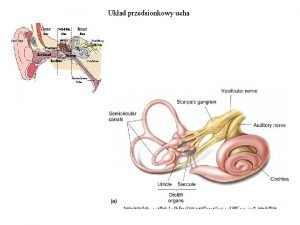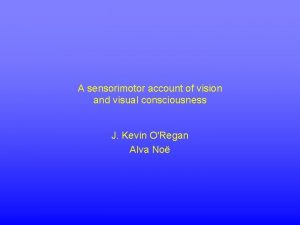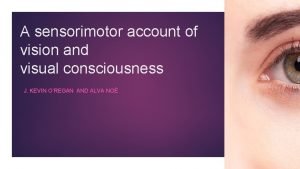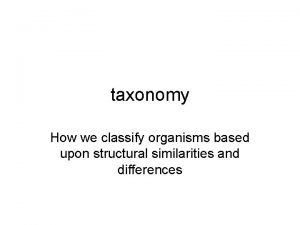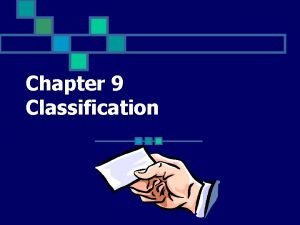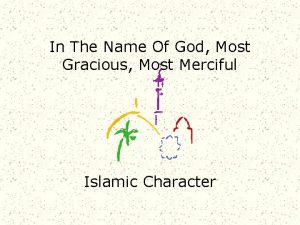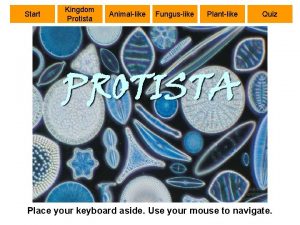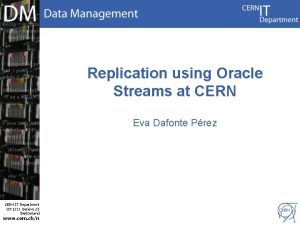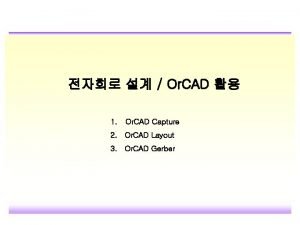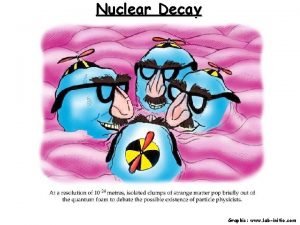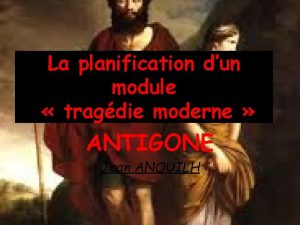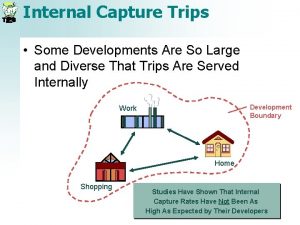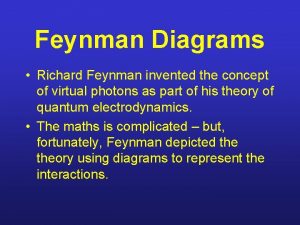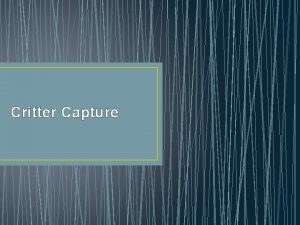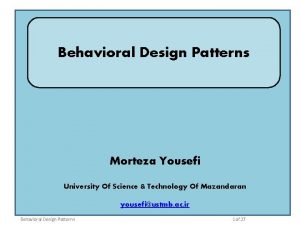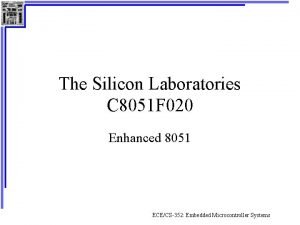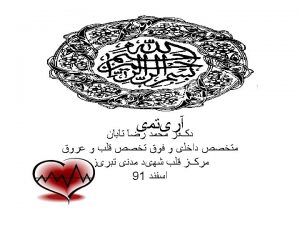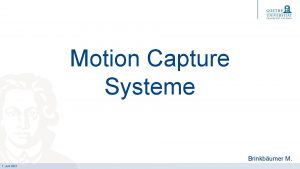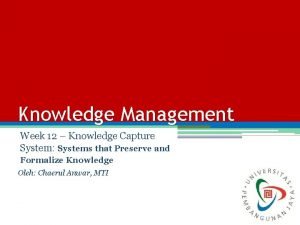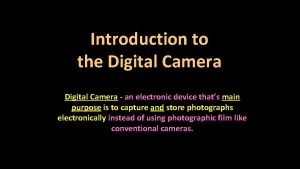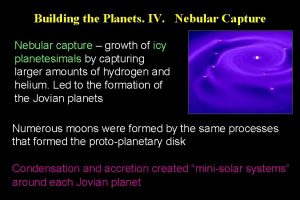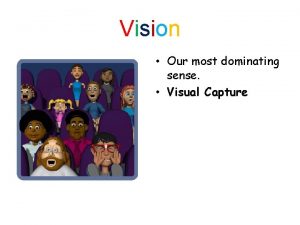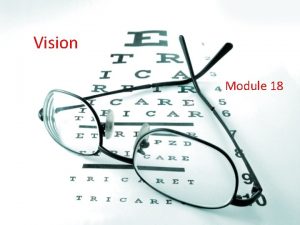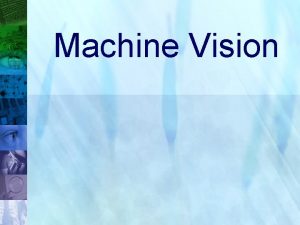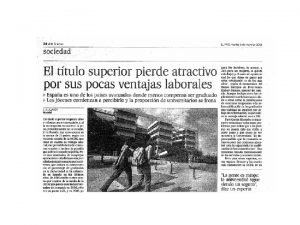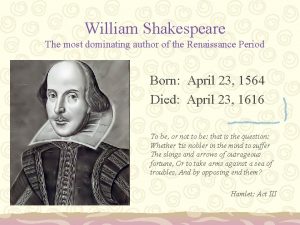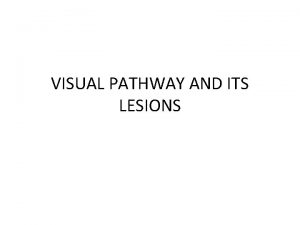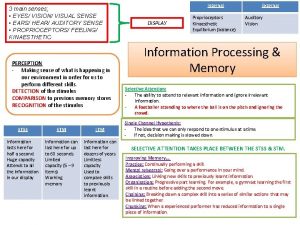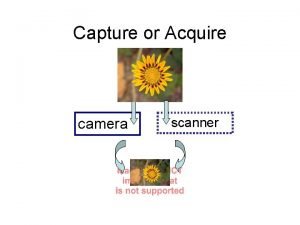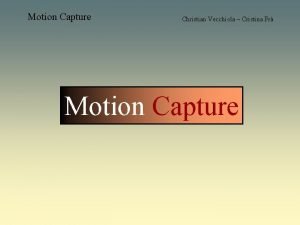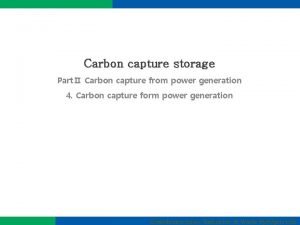Vision Most Dominating Sense Visual Capture Overview of

































































- Slides: 65

Vision • Most Dominating Sense – Visual Capture

Overview of the Process

Transduction • Transforming signals into neural impulses. • Information goes from the senses to the thalamus, then to the various areas in the brain.

What is Color

Phase One: Gathering Light • Wavelength = hue (color). – Longer = more red. – Shorter = more blue. • Wave Amplitude (height) = intensity (brightness). – ↑ Amplitude = ↑Brightness – ↓Amplitude = ↓ Brightness • ROY G BIV

Wavelength (Hue) Violet Indigo 400 nm Short wavelengths Blue Green Yellow Orange Red 700 nm Long wavelengths Different wavelengths of light result in different colors.

Intensity (Brightness) Amplitude Blue color with varying levels of intensity. As intensity increases or decreases, blue color looks more “washed out” or “darkened. ”

Phase Two: Getting the light in the eye

The Structure of the Eye

The Structure of the Eye Cornea = outer covering of the eye, bends light to provide focus.

The Structure of the Eye Pupil = the adjustable opening in the center of the eye through which light enters.

The Structure of the Eye Iris = a ring of muscle tissue that forms the colored portion of the eye around the pupil and controls the size of the pupil opening. • The iris dilates/constricts in response to changing light intensity

The Structure of the Eye Lens = the transparent structure behind the pupil that changes shape to help focus images on the retina. (accommodation)

The Structure of the Eye Retina = the light-sensitive inner surface of the eye, containing the receptor rods and cones plus layers of neurons that begin the processing of visual information.

Nearsighted & Farsighted Vision

The Eye The Retina • Rods and Cones Rods

Rods versus Cones

Phase Three: Transduction The Retina’s Reaction to Light

The Retina’s Reaction to Light

The Retina’s Reaction to Light

The Retina’s Reaction to Light

The Retina’s Reaction to Light

The Structure of the Eye Fovea = the central focal point in the retina, around which the eye’s cones cluster.

The Structure of the Eye Optic Nerve = the nerve that carries neural impulses from the eye to the brain.

The Structure of the Eye Blind Spot = the point at which the optic nerve leaves the eye, creating a “blind” spot because no receptor cells are located there.

The Eye The Retina • Blind spot

Blind Spots

Blind Spots

Transduction Continued • Order is: 1) 2) 3) 4) 5) 6) Rods/Cones Bipolar Ganglion Optic Nerve Thalamus Cerebral Cortex (Occipital Lobe)

Visual Information Processing Visual Cortex

Pathways from the eyes to the visual cortex

Pathways from the eyes to the visual cortex

Pathways from the eyes to the visual cortex

The Structure of the Eye Blind Spot = the point at which the optic nerve leaves the eye, creating a “blind” spot because no receptor cells are located there.

The Eye The Retina • Blind spot

Blind Spots

Blind Spots

Transduction Continued • Order is: 1) 2) 3) 4) 5) 6) Rods/Cones Bipolar Ganglion Optic Nerve Thalamus Cerebral Cortex (Occipital Lobe)

Visual Information Processing Visual Cortex

Pathways from the eyes to the visual cortex

Pathways from the eyes to the visual cortex

Pathways from the eyes to the visual cortex

Pathways from the eyes to the visual cortex

Phase Four: In the Brain Visual Information Processing • Goes to the Visual Cortex located in the Occipital Lobe of the Cerebral Cortex • Feature Detectors • Parallel Processing We have specific cells that see the lines, motion, curves and other features of this turkey. These cells are called feature detectors.

Visual Information Processing Feature Detection • Feature detectors

Visual Information Processing Parallel Processing • Parallel processing

Parallel Processing • The processing of several aspects of a problem simultaneously. Color Motion Form Depth

Visual Information Processing

Visual Information Processing

Visual Information Processing

Visual Information Processing

Visual Information Processing

Visual Information Processing

Reviewing the Process • http: //www. youtube. com/watch? v=Qk. Zn_yt urd. I&feature=related • http: //www. youtube. com/watch? v=Jada. WSD x. BYk&feature=related

Color Vision Two Major Theories

Trichromatic Theory Three types of cones: • Red • Blue • Green • These three types of cones can make millions of combinations of colors. • Does not explain afterimages well. • Monochromatic vs. Dichromatic Vision

Opponent-Process theory The sensory receptors come in pairs. • Red/Green • Yellow/Blue • Black/White • If one color is stimulated, the other is inhibited • Explains Afterimages

After Images

After Image

This slide is intentionally left blank.

After Image

After Image

After Image

Blind Sight

Blind Sight
 Vertex cover to dominating set
Vertex cover to dominating set Failure to sense
Failure to sense Failure to pace vs failure to capture
Failure to pace vs failure to capture Dominant genetic variance
Dominant genetic variance Narrow sense heritability vs broad sense heritability
Narrow sense heritability vs broad sense heritability Bottom up processing
Bottom up processing Binocular vision and space perception
Binocular vision and space perception Introduction to visual basic
Introduction to visual basic Vestibular
Vestibular Whose philosophy made the most sense
Whose philosophy made the most sense Structured light
Structured light A sensorimotor account of vision and visual consciousness
A sensorimotor account of vision and visual consciousness Consciousness outside the brain
Consciousness outside the brain Contoh pemrograman konvensional
Contoh pemrograman konvensional Most general to most specific classification
Most general to most specific classification Most general to most specific classification
Most general to most specific classification In the name of allah the most gracious
In the name of allah the most gracious In the name of allah the most beneficent the most merciful
In the name of allah the most beneficent the most merciful Beneficent pronunciation
Beneficent pronunciation In the name of allah the most beneficent the most merciful
In the name of allah the most beneficent the most merciful Organisms taxonomy
Organisms taxonomy Arrangement of organisms
Arrangement of organisms In the name of god most gracious most merciful
In the name of god most gracious most merciful In the name of allah the most gracious the most merciful
In the name of allah the most gracious the most merciful In the name of allah the beneficent the merciful in arabic
In the name of allah the beneficent the merciful in arabic In the name of god most gracious most merciful
In the name of god most gracious most merciful Akhlaq meaning
Akhlaq meaning In the name of god most gracious prayer
In the name of god most gracious prayer Allah the most beneficent
Allah the most beneficent Hybrid capture 2
Hybrid capture 2 Structured data capture
Structured data capture Quiz 3: plant- and fungus-like protists
Quiz 3: plant- and fungus-like protists Repl capture/apply: memory
Repl capture/apply: memory Contoh value creation adalah
Contoh value creation adalah Capture 2 proposal
Capture 2 proposal Cad capture
Cad capture Beta radiation
Beta radiation Capture the spread
Capture the spread Tegrity lecture capture
Tegrity lecture capture La double énonciation dans antigone
La double énonciation dans antigone Internal capture
Internal capture Midori kitagawa
Midori kitagawa River capture definition
River capture definition Feynman diagram electron capture
Feynman diagram electron capture Exploring the water cycle capture sheet answers
Exploring the water cycle capture sheet answers Rave electronic data capture
Rave electronic data capture Data capture methods
Data capture methods Critter capture
Critter capture Knowledge capture systems
Knowledge capture systems Sp_cdc_scan
Sp_cdc_scan Brainware ocr
Brainware ocr Internal capture
Internal capture Automatic data capture methods
Automatic data capture methods Exploring the water cycle capture sheet
Exploring the water cycle capture sheet Capture mode in pic microcontroller
Capture mode in pic microcontroller Omp atomic capture
Omp atomic capture Aberency
Aberency Azure database cdc
Azure database cdc Ddx
Ddx Text data capture forms
Text data capture forms Performance capture verfahren
Performance capture verfahren Knowledge capture system
Knowledge capture system Is camera electronic device
Is camera electronic device Motion capture history
Motion capture history Feedback grid
Feedback grid Nebular capture
Nebular capture
